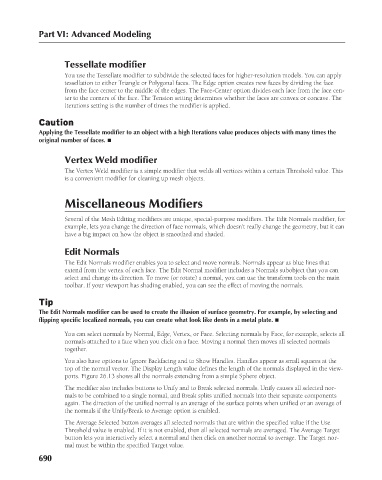Page 738 - Kitab3DsMax
P. 738
Part VI: Advanced Modeling
Tessellate modifier
You use the Tessellate modifier to subdivide the selected faces for higher-resolution models. You can apply
tessellation to either Triangle or Polygonal faces. The Edge option creates new faces by dividing the face
from the face center to the middle of the edges. The Face-Center option divides each face from the face cen-
ter to the corners of the face. The Tension setting determines whether the faces are convex or concave. The
Iterations setting is the number of times the modifier is applied.
Caution
Applying the Tessellate modifier to an object with a high Iterations value produces objects with many times the
original number of faces. n
Vertex Weld modifier
The Vertex Weld modifier is a simple modifier that welds all vertices within a certain Threshold value. This
is a convenient modifier for cleaning up mesh objects.
Miscellaneous Modifiers
Several of the Mesh Editing modifiers are unique, special-purpose modifiers. The Edit Normals modifier, for
example, lets you change the direction of face normals, which doesn’t really change the geometry, but it can
have a big impact on how the object is smoothed and shaded.
Edit Normals
The Edit Normals modifier enables you to select and move normals. Normals appear as blue lines that
extend from the vertex of each face. The Edit Normal modifier includes a Normals subobject that you can
select and change its direction. To move (or rotate) a normal, you can use the transform tools on the main
toolbar. If your viewport has shading enabled, you can see the effect of moving the normals.
Tip
The Edit Normals modifier can be used to create the illusion of surface geometry. For example, by selecting and
flipping specific localized normals, you can create what look like dents in a metal plate. n
You can select normals by Normal, Edge, Vertex, or Face. Selecting normals by Face, for example, selects all
normals attached to a face when you click on a face. Moving a normal then moves all selected normals
together.
You also have options to Ignore Backfacing and to Show Handles. Handles appear as small squares at the
top of the normal vector. The Display Length value defines the length of the normals displayed in the view-
ports. Figure 26.13 shows all the normals extending from a simple Sphere object.
The modifier also includes buttons to Unify and to Break selected normals. Unify causes all selected nor-
mals to be combined to a single normal, and Break splits unified normals into their separate components
again. The direction of the unified normal is an average of the surface points when unified or an average of
the normals if the Unify/Break to Average option is enabled.
The Average Selected button averages all selected normals that are within the specified value if the Use
Threshold value is enabled. If it is not enabled, then all selected normals are averaged. The Average Target
button lets you interactively select a normal and then click on another normal to average. The Target nor-
mal must be within the specified Target value.
690

